
How would you like to learn a harmonic price action pattern that can produce up to an 80% strike-rate? If that interests you, you’re in luck!
In this article, I’m going to show you (in detail) how to trade the profitable harmonic cypher pattern.
There is a lot of information going around on how to trade this lucrative pattern. Not all of it is correct.
I’m going to show you how to trade the cypher pattern the right way. I’m also going to show you a couple of tricks that I have learned to help you qualify the best cypher patterns to trade.
Harmonic cypher pattern trading works in every market, but the examples in this article will be geared toward the Forex market.
Regular readers of this site already know about my free price action course. The cypher pattern is the first in a series of advanced harmonic price action patterns that I will be adding to the course.
What is a Harmonic Cypher Pattern?
The cypher pattern is an advanced harmonic price action pattern that, when traded correctly, can achieve a truly outstanding strike-rate as well as a pretty good average reward-to-risk ratio.
Let’s start with the basics, in case you’re completely unfamiliar with cypher pattern trading.
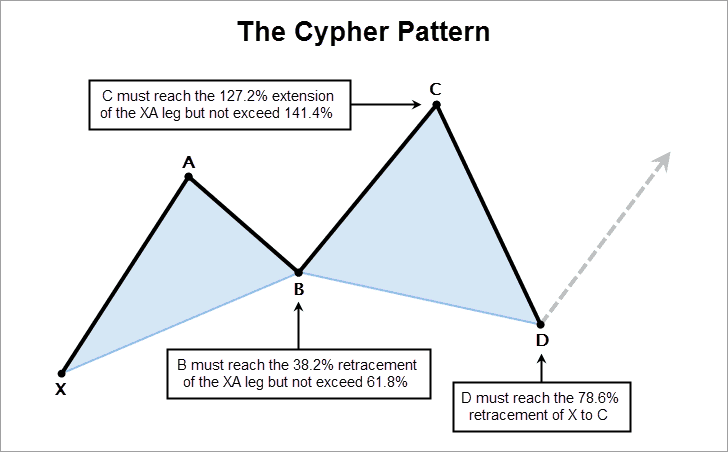
A qualified cypher pattern consists of an impulse leg (XA), followed by a retracement leg (AB) that reaches at least the 38.2% Fibonacci retracement of the XA leg without exceeding 61.8%.
Note: If you need help learning how to correctly use your Fibonacci retracement tool, check out my article on Fibonacci retracement and extension basics.
You’ll have to learn how to use the manual Fibonacci tool for this pattern because an automatic Fibonacci tool will most likely not be drawn on the exact leg of this pattern that you need it to be drawn on at the exact time that you are trying to qualify this pattern.
If your AB leg fits within the qualified Fibonacci retracement range, you’ll now look for a continuation leg (BC) that must at least reach the 127.2% Fibonacci extension of the XA leg without exceeding 141.4%.
Next, a Fibonacci retracement of X to C is drawn. The qualified cypher pattern is complete when the CD leg reaches 78.6% of that retracement.
Wicks Are Okay
When I mentioned that the AB leg must not exceed a retracement of 61.8% and the BC leg must not exceed an extension of 141.4%, I’m talking about closed candles.
It’s okay for the wicks to exceed those levels as long as the candles don’t close beyond them.
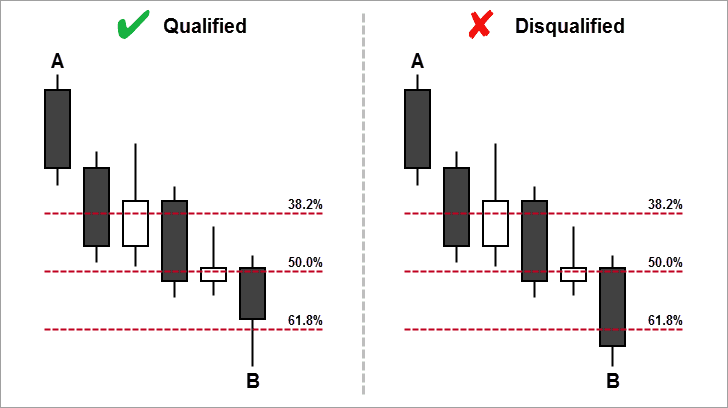
For instance, the examples above show bullish harmonic cypher patterns in which the AB legs have moved below the 61.8% Fibonacci retracement levels.
In the first example (left), the wick pierced below the 61.8% level and then closed above it, which is still valid.
The second example (right) not only pierced below the 61.8% level but closed below it, which would invalidate that pattern.
Note: Remember to apply the same concept to the 141.4% extension level of XA when qualifying the BC leg of the pattern as well.
The “B” Rule
I haven’t seen many people mention this next concept, but it’s an important one. I’m calling this the “B” rule to help you remember it.
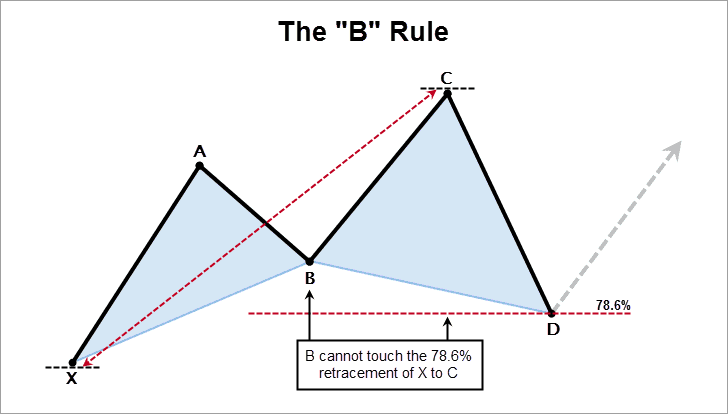
The rule is simple. Basically, B cannot touch the 78.6% retracement of X to C (see the image above). This rule includes the candlestick wicks.
Note: You usually don’t have to worry about B touching the 78.6% retracement of X to C. However, when you get a deep retracement as well as a deep extension of the XA leg, it’s more likely to happen.
Trading the Harmonic Cypher Pattern
Now that you know how to identify and qualify the harmonic cypher pattern, let’s go over how to trade the pattern (in detail).
The following are standard methods of trading the cypher pattern. Later, I’ll go over a technique that I use to improve my odds on certain instances of this pattern.
Entry
Earlier, I mentioned drawing a Fibonacci retracement of X to C to qualify the CD leg of the cypher pattern. When the CD leg reaches the 78.6% retracement level, the cypher pattern is complete and valid.
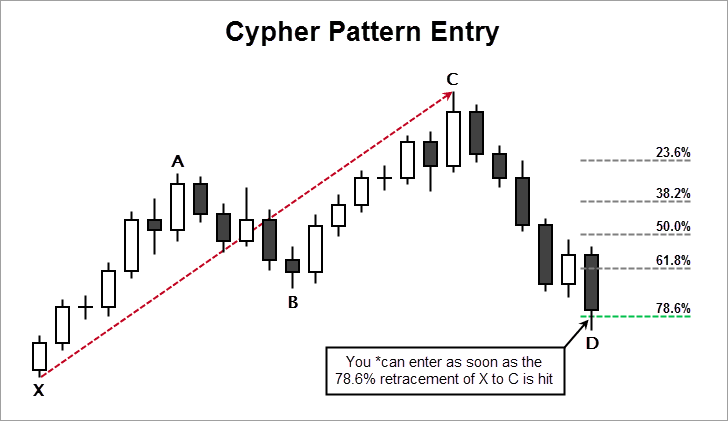
However, the 78.6% Fibonacci retracement level of X to C also acts as the standard entry point for a valid cypher pattern trade (see the image above).
*Note: Later, I’ll show you why you should delay your entry on certain cypher patterns to improve your reward to risk ratio.
Take Profit
There are a couple of ways to take your profits with the cypher pattern, but the standard technique is to scale out of your position at the first take profit level and close your trade at the second take profit level.
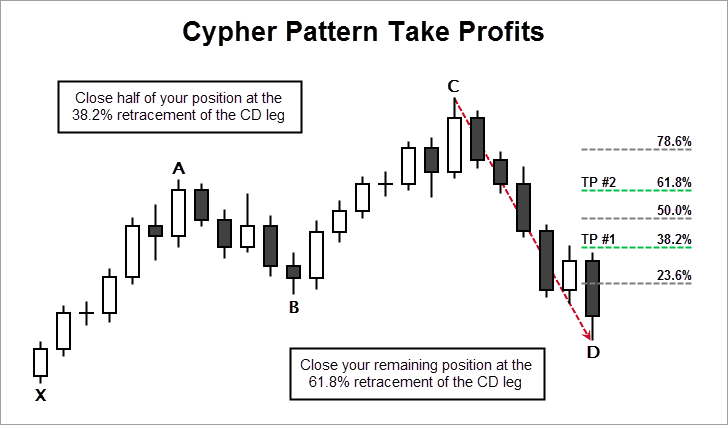
To get your take profit levels, you draw a Fibonacci retracement of the CD leg (see the image above).
Your first take profit level is the 38.2% retracement of CD. The second take profit level is 61.8%.
When price reaches the 38.2% level (TP #1), close half of your open position. When price reaches the 61.8% level (TP #2) close your remaining position to exit the trade.
Note: Alternately, you could close your entire position at the 38.2% retracement, taking advantage of the high strike-rate of the cypher pattern to provide an edge.
You’ll win more trades this way, but take less profit per winning trade, so test to see which technique works better for you.
Stop Loss
Be sure to give your trade at least 10 pips space beyond X on your intraday charts.
If you’re trading a bullish cypher pattern (as in the example below), place your stop loss at least 10 pips below the low of X.
Place your stop loss at least 10 pips above the high of X in the case of a bearish cypher pattern.
*Note: If you’re trading the daily charts, you may need to give your trade more breathing room. 20 – 30 pips or even more may be more appropriate, depending on the movement of the pair and the average daily range.
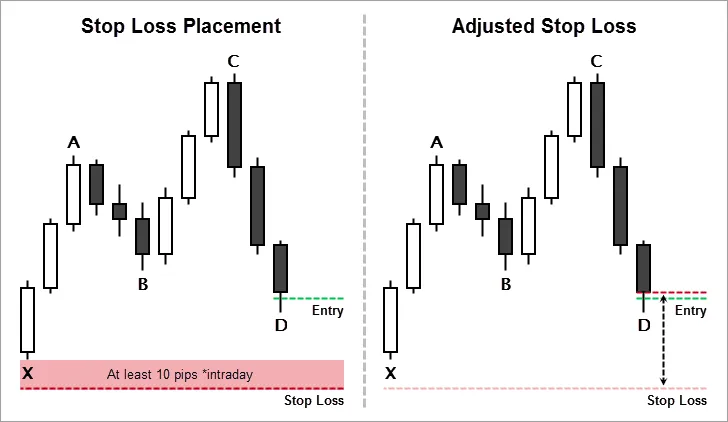
According to the standard cypher pattern trading method, you should adjust your stop loss to your entry point once the first take profit (TP #1) is hit.
I like to add an additional 2 or 3 pips to cover my trading costs when adjusting my stop loss (see the image above), although it’s not really necessary if you’re planning to scale out at TP #1.
Do you use MetaTrader 4? If so, you can use this break even EA to automatically adjust your stop loss when price reaches TP #1.
Note: If you see the pattern a little late, don’t worry. You may still be able to get into the trade.
The example above is a bullish cypher pattern. In this case, the pattern remains valid until price either breaks above the standard entry point (far enough to trigger your adjusted stop loss) or price breaks below X.
If price breaks above the entry point, but does not trigger your adjusted stop loss, and comes back down to your entry level or lower, you can still enter that trade.
What Makes a Good Harmonic Cypher Pattern?
Harmonic cypher pattern trading can be very profitable. In fact, many traders claim to make consistent monthly returns using nothing but the cypher pattern.
As I mentioned earlier, this pattern can achieve up to an 80% strike-rate. With numbers like that on your side, you would be foolish to not implement the cypher pattern into your own trading plan.
However, the cypher pattern isn’t perfect.
One disadvantage of the cypher pattern is that it has a tendency to provide trading setups in which the reward to risk ratio leans more toward risk than reward (at least at the first take profit level).
To make things worse, if the CD leg continues to retrace after you entered the trade (as it often does), you must continue to adjust your Fibonacci retracement of the CD leg.
That means your take profit levels will continue to move closer and closer to your entry point.
Unfortunately, there’s no way to guarantee that the CD leg will not continue to retrace.
However, you can combat the overall reward to risk problem by filtering out cypher pattern setups that don’t start with a near 1:1 reward to risk ratio or better.
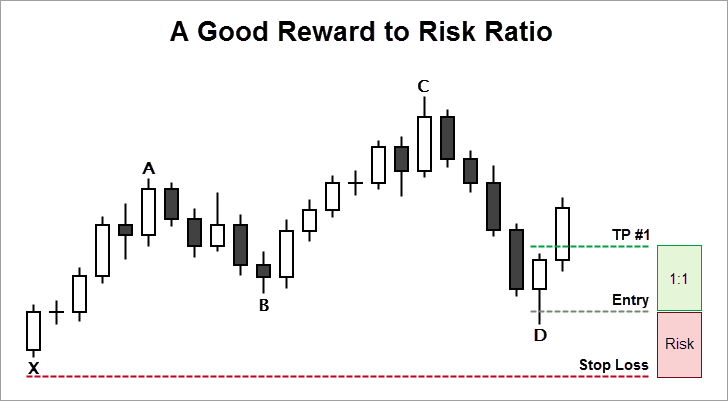
In other words, don’t enter cypher pattern trades where your risk is larger than your reward at TP #1 (see the image above).
Note: It doesn’t need to be an exact number, just in the ballpark. You should be able to judge whether or not the reward to risk ratio is good enough with a glance.
Here’s where it gets interesting. If you find a cypher pattern with a poor reward to risk ratio, you may still be able to take that trade if you can get an improvement on your entry point (see the image below).
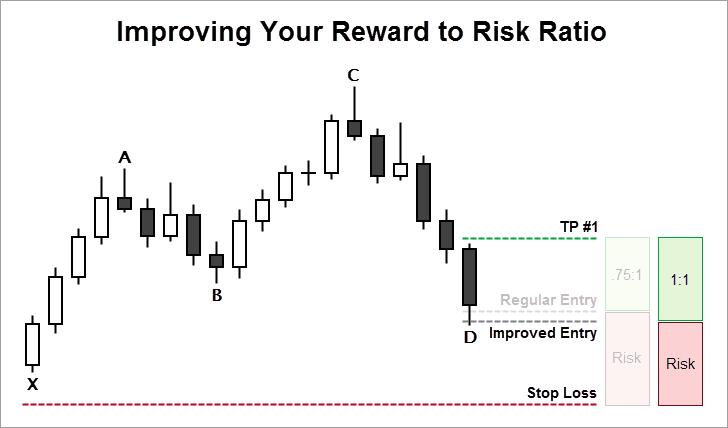
As I mentioned earlier, often the CD leg continues to retrace past the 78.6% level. When it does, you can use that to your advantage by entering the trade with a better initial reward to risk ratio.
Remember: The cypher pattern remains valid until price retraces past X or reaches the first take profit level (TP #1), which would trigger your adjusted stop loss if you were already in the trade.
Final Thoughts
The harmonic cypher pattern has become a very popular advanced price action pattern, mostly due to the outstanding strike-rate that you can achieve if you use it correctly.
You will not be able to achieve an 80% strike-rate on every pair and in every market condition, but the edge that this pattern provides on a bad day makes it worth learning and implementing.
Each leg in the examples above was pretty straightforward. They moved up or they moved down.
The movements that create real cypher patterns may be more choppy at times, but as long as the movements are within the proper Fibonacci retracements and extensions, the patterns are valid.
Note: Usually, when the movements of the cypher pattern are choppy, they will be more straight forward on a higher time frame.
With that in mind, you should also remember that each leg in the pattern doesn’t need to make it’s move right away. The pattern can go on and on until it’s either qualified or disqualified.
The cypher pattern works on any time frame.
Traders that specialize in the cypher pattern trade it on time frames as low as the 5M. However, I’m not personally a fan of going lower than the 15M time frame for most trading setups in Forex.
When going lower than the 15M charts, the spread and the 10 pip stop loss become relatively too large to deal with in a consistently profitable way.
If you’re intent on trading shorter time frames than 15 minutes, you may want to experiment with using less than 10 pips below X as your stop loss.
That’s just my two cents.
Be sure to backtest and demo trade the cypher pattern using the exact techniques and time frames that you plan to use in your live trading.
Was this harmonic cypher pattern trading guide helpful to you? I hope the instructions in this article have been clear and concise. If you have any questions or comments, please leave them below.


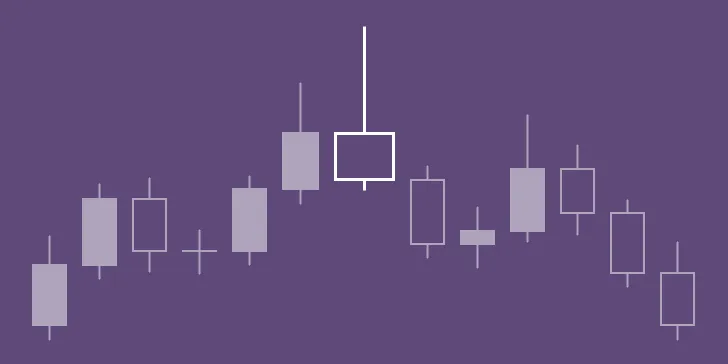
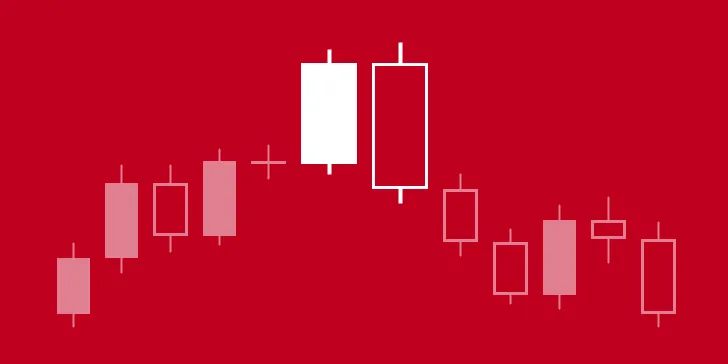
Thanks Chris and very through on your explanation.I’ll keep my eyes open.
Thanks for the kind words, Robby.
Hi Chris, Excellent article and looking forward to learning more about the other patterns. Does the AB retracement of XA have to form exactly on a Fib Level or just anywhere within the 38.2 – 61.8 range? Likewise the 127.2 – 141.4 extn level of XAB? Could you trade Regular Divergence for the ABC pattern knowing the target is Pt D at the 78.6 Fib Retracement of XC ?
Thanks for the comments, Angela. Good questions. You are correct about the retracements and extensions. They just need to fall somewhere within those ranges without exceeding them with a close before reversing.
As far as regular divergence off A and C goes, others have asked that question before. However, I’ve never done tests to see how often that trade would hit the mark. It’s worth looking into, though.
I prefer to trade regular divergence when a trend is likely exhausted (increasing the chances of a reversal). In the case of the cypher pattern, the trend making up XABC wouldn’t necessarily be exhausted.
When does X start?
Good question, Christian! The XA leg (or impulse leg) will be an obvious move. It can come after a period of consolidation (or a retracement) as a continuation move or it can be a reversal of the previous trend.
Of course, when you find this pattern, you will not even begin to consider it to be a possible valid cypher pattern until the CD leg is forming. Or at the very least, you may start watching to see if the BC leg will reverse withing the valid range.
In other words, the XA leg will have already formed. It should be pretty obvious at that point.
Good job from you mate.waiting to learn other pattern too from you.i find this very helpful
Thanks for the kind words! I will be covering other harmonic patterns as well as other long-term price action patterns in the near future.
High Chris, nice page you’ve got here just started the price action course. Have you got any harmonic indicator for rookies 😉
Thank you! I haven’t personally tested any harmonic indicators yet. However, one of my Facebook followers suggested Formation Seeker to me. He said he had tried many and liked that one the most. It’s a premium subscription, though. I believe he said you could do a 10-day trial for $1 or $10. I’m planning to review it in the future, but I have other things I need to get to first. Let us know how it goes if you try it out.
Hey Chris.thanx for such an insight on cypher pattern I’m looking forward to learn more from you on price actions.
Thanks for reading. I’m glad you found this useful.
awesome insight on harmonic patterns Chris…waiting for more …
Got a question though…After the 76.8% i.e point D is hit, is it advisable to wait for any candle reverse pattern …just to be sure or to validate the cypher pattern??
You could do that, James, as long as you’re consistent with your trading rules. In other words, don’t do it sometimes and not others. The cypher pattern is already a great signal in itself. It’s not really necessary to wait for extra confirmation for the entry.
In theory, what you’re talking about doing sounds good. However, in practice, you may end up with a bunch of late entries because you waited too long.
There always a balance in trading between waiting for good confirmation and waiting so long that the move has already happened. That being said, I haven’t tried what you’re talking about, so just test it. Let me know if it works for you. Good luck!
i just read this post and it helped me a lot, thanks.
about entry and exit i like to use “elliot wave” counting so i am sure to enter at exactly the right moment when pattern is done.
My question is what if one of the required levels isnt reached what then?
stay away from it all together? by testing it i found it often doesnt happen but still continous trend.(cd leg) often C doesnt go that high or D not so low…
If the levels that I mentioned aren’t reached, then it’s not a real cypher pattern. There’s always a 33.33% chance the trend will go the way you want it to go on any random guess. We’re trying to get the odds in our favor. The beauty of waiting for a real cypher pattern is that the odds of the market moving in your favor (at least to your first TP) is up to 80%.
Hi Chris.. I want to know if the wick passes 161.8 retracemen. Will the pattern be valid? Or if the wick passes 1.4242 extension is it valid?
When qualifying these patterns, the wicks aren’t as important as where the real body closes… within reason. A super long wick could be a sign of market manipulation.
*78.6%…typing error
Hi, I’m new in technical analysis.
I never understood how or where the values 1.272, 0.382 was relationated. But with your explain and GRAPH, I see all clear and see how validate B and D and trade. Thanks Chris.
Thanks for reading, Olivia. I tried to be as thorough as I could be to make things as clear as possible. I’m glad this helped you. Good luck!
I extremely like the book, the book is fabulous.
Thanks Chris for help
Thanks for reading and thanks for the kind words. I’m glad I could help you.
I can’t really wait to practice finding my 1st harmonic #cypher I choose u????
I’m glad you found this useful. Good luck!